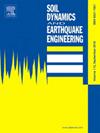Fast calculation method for soil dynamics under harmonic loads by 2.5D FEM and RBM combination technique
IF 4.2
2区 工程技术
Q1 ENGINEERING, GEOLOGICAL
引用次数: 0
Abstract
A comprehensive analysis of soil dynamics is essential for accurately predicting the environmental impacts of subway operations. However, traditional finite element methods become computationally expensive when dealing with high-frequency disturbances and large-scale effects. To overcome the challenge, this study proposes a hybrid approach that integrates 2.5D FEM with the reduced basis method (RBM) to enhance computational efficiency. First, the solution of vibration transfer functions of the soil system is derived based on 2.5D FEM, and its accuracy is validated against two benchmark examples. Subsequently, RBM is introduced to establish reduced-order models in both the frequency and wavenumber domains. In this case study, the proposed method demonstrates higher accuracy than the linear interpolation method, significantly reducing truncation errors. Specifically, the statistical error of the linear interpolation method is found to be 3 to 35 times greater than that of the proposed approach. Moreover, the proposed method achieves an approximately 75 % reduction in computational effort by avoiding inefficient repeat calculations when new parameters are introduced in traditional FEM approaches. However, it is important to note that the effectiveness of the proposed method depends significantly on the number of pre-computed solutions used to construct the reduced basis space. Computational efficiency improves as the sampling interval decreases. Thus, the proposed method is recommended when there are a sufficient number of pre-computed solutions, in addition to the linear interpolation method. Moreover, its application in reproducing the high-frequency subway-induced ground vibrations shows that the proposed method has a good effect. In conclusion, this study provides a novel computational method with high accuracy and efficiency, which has a significant potential for application in more complex soil dynamic problems in transportation and earthquake engineering.
求助全文
约1分钟内获得全文
求助全文
来源期刊

Soil Dynamics and Earthquake Engineering
工程技术-地球科学综合
CiteScore
7.50
自引率
15.00%
发文量
446
审稿时长
8 months
期刊介绍:
The journal aims to encourage and enhance the role of mechanics and other disciplines as they relate to earthquake engineering by providing opportunities for the publication of the work of applied mathematicians, engineers and other applied scientists involved in solving problems closely related to the field of earthquake engineering and geotechnical earthquake engineering.
Emphasis is placed on new concepts and techniques, but case histories will also be published if they enhance the presentation and understanding of new technical concepts.
 求助内容:
求助内容: 应助结果提醒方式:
应助结果提醒方式:


